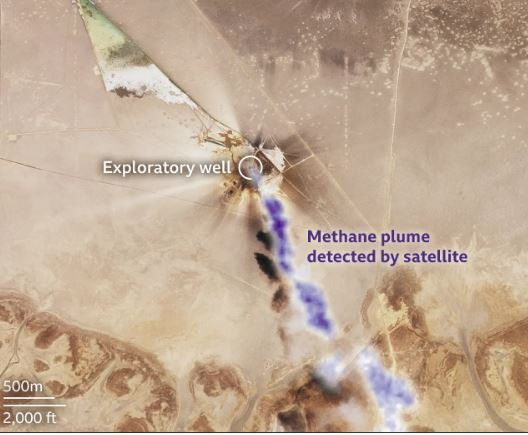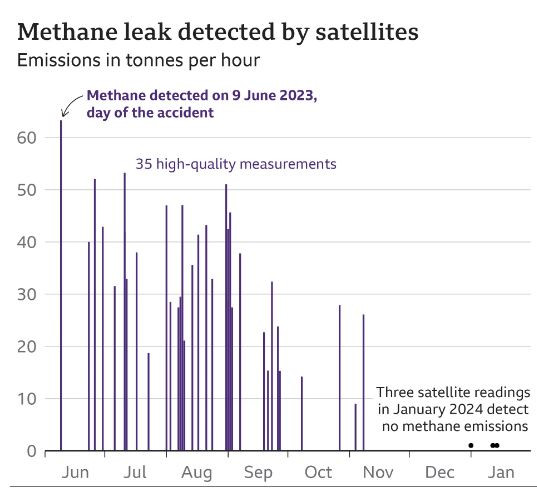An estimated 127,000 tonnes of natural gas escaped when an explosion sparked a fire that burned for more than six months
One of the worst methane leaks on record occurred last year at a remote well in Kazakhstan, new analysis has shown, BBC Verify has learned.
An estimated 127,000 tons of natural gas escaped when an explosion ignited a fire that burned for more than six months. Methane is a much more potent greenhouse gas than carbon dioxide.
Buzachi Neft, the company that owns the well, denies that a “significant amount” of methane has leaked.
According to the US Environmental Protection Agency’s Greenhouse Gas Equivalence Calculator, the environmental impact of such a spill is comparable to that of emitting more than 717,000 diesel cars for a year.
“The size and duration of the leak is frankly extraordinary,” said Manfredi Caltagirone, head of the UN’s International Observatory for Methane Emissions. “It is extremely large.”
The leak began on June 9, 2023, when an explosion was reported while drilling an exploratory well in the Mangistau region of southwestern Kazakhstan, causing a fire that burned continuously until the end of the year.
It was only brought under control on December 25, 2023. Local authorities told the BBC that work is currently underway to seal the well with cement.
Natural gas consists mainly of methane, a gas that is transparent to the human eye.
But when sunlight passes through a methane cloud, it creates a unique fingerprint that some satellites can track.
This particular methane leak was first investigated by the French geoanalytics company, Kayrros. Their analysis has now been verified by the Netherlands Institute for Space Research and the Polytechnic University of Valencia, Spain.
Looking at satellite data, the scientists found that high concentrations of methane were visible on 115 separate occasions between June and December.
Based on these readings, they concluded that 127,000 tons of methane escaped from this well.
That could make it the second-worst human-caused methane leak ever recorded.
Luis Guanter of the Polytechnic of Valencia, who helped verify the leak, says “only the sabotage of Nord Stream could have led to a stronger leak.”
According to the International Energy Agency, methane is responsible for about 30% of the rise in global temperatures since the Industrial Revolution.
While satellite readings can be affected by external factors such as cloud cover, scientists say they are “absolutely certain” that massive amounts of methane escaped from this well.
“We detected methane plumes from five different methane-sensitive satellite instruments,” said Mr Guanter. “Each of these instruments measures methane in a specific way, but we got very consistent readings from all of them.”
In a statement, the Department of Ecology in the Mangistau district confirmed that the concentration of methane in the air exceeded legal limits on 10 separate occasions between June 9 and September 21.
He also said that, in the hours following the initial explosion, methane levels in the air were 50 times higher than permitted.
Source: Skai
I have worked as a journalist for over 10 years, and my work has been featured on many different news websites. I am also an author, and my work has been published in several books. I specialize in opinion writing, and I often write about current events and controversial topics. I am a very well-rounded writer, and I have a lot of experience in different areas of journalism. I am a very hard worker, and I am always willing to put in the extra effort to get the job done.












